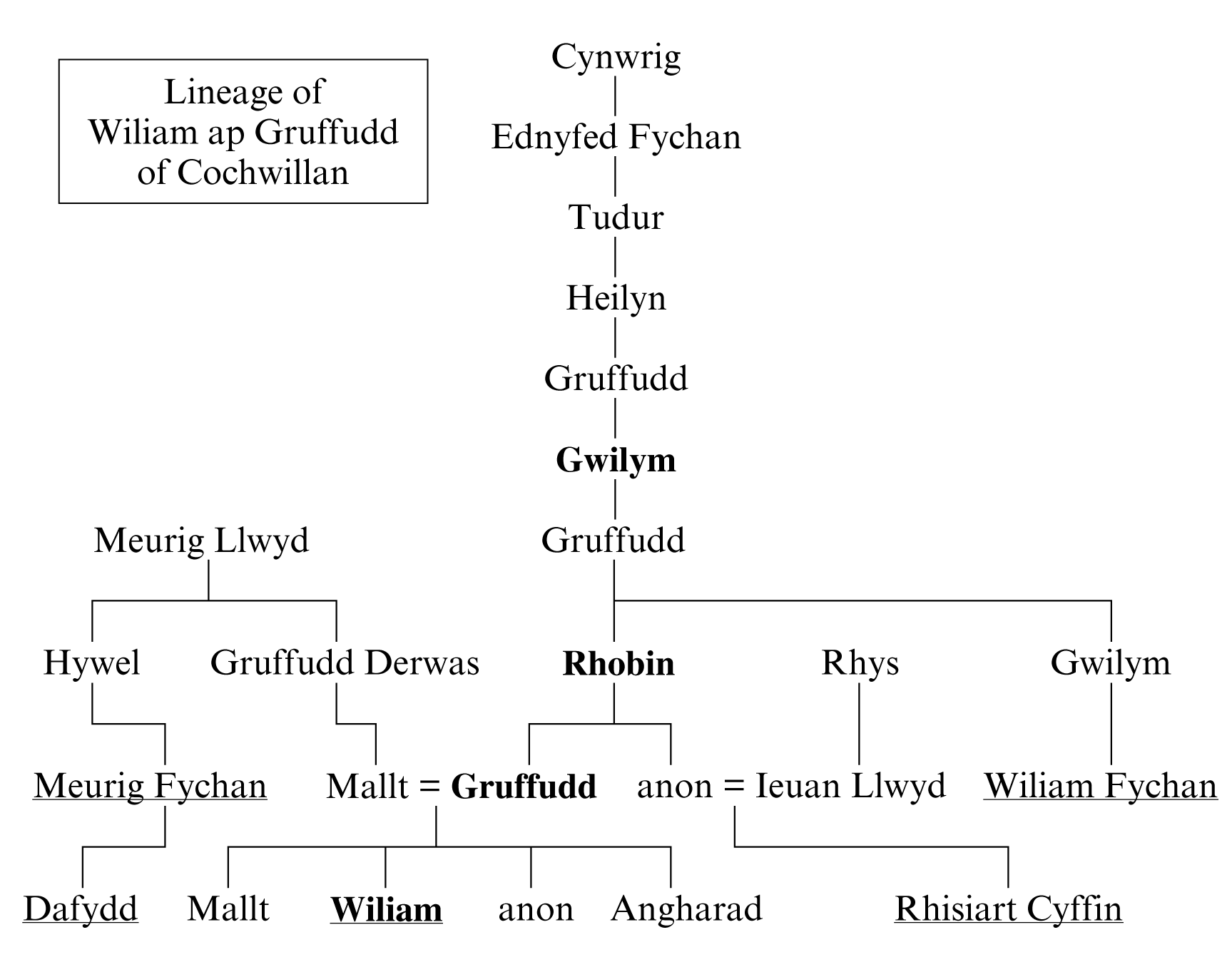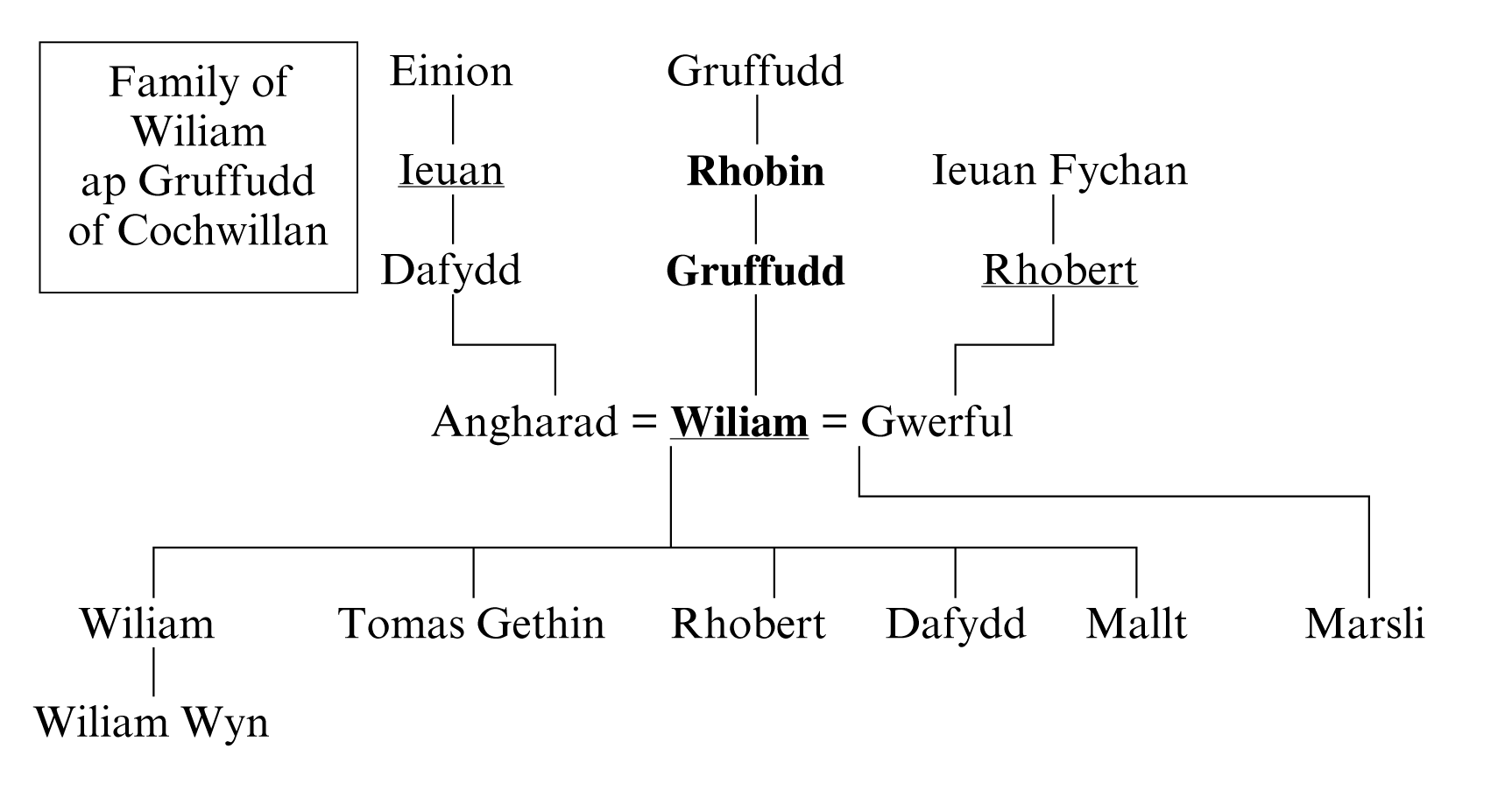Guto composed a poem of praise for Wiliam ap Gruffudd (poem 55). Five other poems for Wiliam have survived:
- two poems of praise by Lewys Môn, GLM poems XLII and XLIII;
- a notable poem of thanks for a horse by Dafydd Llwyd of Mathafarn, GDLl poem 51;
- a poem by Ieuan Deulwyn to request oxen from Wiliam and other patrons in Gwynedd (including Rhisiart Cyffin, dean of Bangor, and, possibly, Wiliam Fychan of Penrhyn) on behalf of Sir Rhys ap Thomas of Abermarlais, ID poem XXIV;
- an elegy by Lewys Daron, GLD poem 8.
Lewys Môn composed an elegy for his first wife, Angharad daughter of Dafydd (GLM poem XLIV). His son, Wiliam, was also a generous patron, and poems to him survive by Gruffudd Hiraethog, Lewys ab Edward, Lewys Daron, Lewys Morgannwg, Siôn Brwynog, Siôn ap Hywel and Wiliam Llŷn. Further on the poetry for Wiliam’s ancestors, see below.
Lineage
The genealogical tables below are based on WG1 ‘Bleddyn ap Cynfyn’ 50, 51, ‘Marchudd’ 4, 5, 6, ‘Osbwrn’ 2; WG2 ‘Iarddur’ 5E, ‘Marchudd’ 6 D1, D2, ‘Osbwrn’ 2 A1; GLM poem XLIV. Those named in Guto’s poem are shown in bold print, and the names of his patrons are underlined.

Lineage of Wiliam ap Gruffudd of Cochwillan
Wiliam was a cousin (or half-cousin) of Rhisiart Cyffin, dean of Bangor, and a second-cousin of Dafydd ap Meurig Fychan of Nannau. His father was a cousin of Wiliam Fychan of Penrhyn. Furthermore, the genealogical table below shows that he was the son-in-law (through his first marriage) of Dafydd ab Ieuan ab Einion of Cryniarth and (through his second marriage) of Rhobert ab Ieuan Fychan of Coetmor.

Family of Wiliam ap Gruffudd of Cochwillan
According to the genealogies, Wiliam had relationships with two other women, Mallt daughter of Cynwrig (with whom he had a daughter named Alis) and Marged daughter of Tomas (with whom he had a son named Morgan). Also named in the genealogies are five other daughters of uncertain parentage, namely Marged, two daughters named Mallt (one may have been a daughter of Angharad daughter of Dafydd), Annes and Gwenllïan.
His family and career
It is no surprise that Guto received patronage from Wiliam ap Gruffudd, who was related to so many notable patrons from Gwynedd and beyond. He was descended from a noble lineage that won renown in the thirteenth century, when Ednyfed Fychan ap Cynwrig served Llywelyn Fawr ab Iorwerth as seneschal. Elidir Sais composed an elegy for Ednyfed (GMB poem 18) and his descendants, through his son, Goronwy, were patrons of note on Anglesey throughout the fourteenth century (GGMD i, 11–12). By the second half of the fourteenth century, Wiliam’s great-grandfather, Gruffudd ap Gwilym ap Gruffudd (who died in 1405), held lands in the Vale of Clwyd, Caernarfonshire and Anglesey as well as in the family’s traditional heartland in Flintshire (Davies 1995: 51–2). He fought against the Crown with his brother, Bleddyn, in the revolt of Owain Glyndŵr, and both had died by October 1406 (Bowen 2002: 60). According to Davies (1995: 51), at the height of his power at the end of the fourteenth century, Gruffudd was the wealthiest man in north Wales. He had keenly taken advantage of the ascendancy of English law in Wales following the Conquest to amass land through marriage.
By the turn of the century it is clear that Gruffudd’s sons, Rhobin, Gwilym and Rhys, had joined the revolt on Owain’s side. However, in August 1405, all three brothers surrendered to the Crown in gaol in Chester, along with four other Welshmen (ibid. 119; Carr 1990: 8–9). According to Carr (ibid. 5), Gruffudd’s lands in Flintshire went to Rhys and his lands in Gwynedd to both Gwilym (who settled in Penrhyn) and Rhobin (in Cochwillan). Rhobin, who was serving the Crown in Caernarfonshire by 1408, died c.1445 (DWB Online s.n. Williams of Cochwillan; DNB Online s.n. Tudor family, forebears of; the following information was gleaned from these two sources, unless stated otherwise). Gwilym ap Sefnyn composed poetry for Rhobin, and both poet and patron are named as witnesses to a number of deeds and documents during the first decades of the fifteenth century (Williams 1997: 84). Rhobin’s son, Gruffudd, was a member of a commission on expenditure in Caernarfonshire and Anglesey in 1466 and is named as an official and a farmer in Caernarfonshire between 1459 and 1475, the year of his death. His son, Wiliam, may also have been a member of the same commission (Evans 1998: 98), in all likelihood the same Wiliam who is named in Evans (ibid. 159 footnote 15) as being active in the work of mustering seven hundred archers in the duke of Worcester’s army in Beaumaris on 18 August 1467, as well as inquiring into the north Wales sea trade on 3 August 1475.
In 1468 Gruffudd’s half-brother, Tomas, was executed in Caernarfon by Wiliam Herbert for supporting the Lancastrian cause in Wales. It is, therefore, unsurprising that Gruffudd’s son, Wiliam, married the daughter of Dafydd ab Ieuan ab Einion, who kept the castle of Harlech for the Lancastrians between c.1460 and 1468, and supported Henry Tudor at Bosworth in 1485 (Evans 1998: 166 footnote 53). He was rewarded by the king by being appointed sheriff of Caernarfonshire for life from 24 September 1485 to his death in 1500 (Breeze 1873: 50; Williams 1956: 249). It is likely that his loyalty also earned him the status of citizenship on 18 January 1486, a record of which in the Calendar of Patent Rolls shows how he was forced to grapple with the aftershocks of the revolt in which his forebears had fought at the beginning of the century (CPR):
Denization of William ap Griffith ap Robyn, native of Wales: and extention to him of the privelages of an Englishman, and enfranchisement from the penal enactments against the Welsh of 2 Henry IV.
It is certainly comparable with Wiliam Fychan’s successful attempt to gain citizenship less than forty years earlier.
Smith (1975: 102) argues that Wiliam rebuilt his home in Cochwillan sometime after 1485 by taking advantage of his newfound status as sheriff of Caernarfonshire (see further 55.15n). Wiliam is referred to as sheriff in Breeze (1873: 50 footnote 18).
Bibliography
Bowen, D.J. (2002), ‘Y Canu i Gwilym ap Gruffudd (m. 1431) o’r Penrhyn a’i Fab Gwilym Fychan (m. 1483)’, Dwned 8: 59–78
Breeze, E. (1873), Kalendars of Gwynedd (London)
Davies, R.R. (1995), The Revolt of Owain Glyndŵr (Oxford)
Evans, H.T. (1998), Wales and the Wars of the Roses (Bridgend)
Smith, P. (1975), Houses of the Welsh Countryside (London)
Williams, G.A. (1997), ‘Cywydd Gwilym ap Sefnyn i Afon Ogwen ac Afon Menai’, Dwned 3: 83–95
Williams, W.O. (1956), Calendar of the Caernarvonshire Quarter Session Records, Vol. 1 (London)





